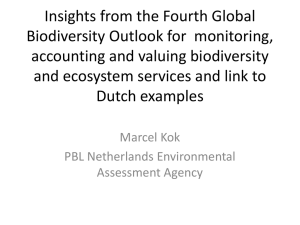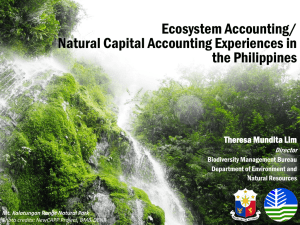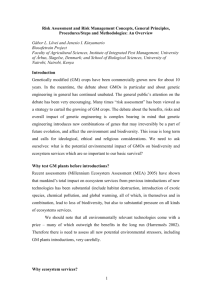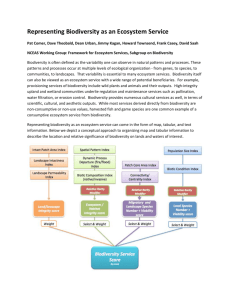Biodiversity and Ecosystem Function
advertisement
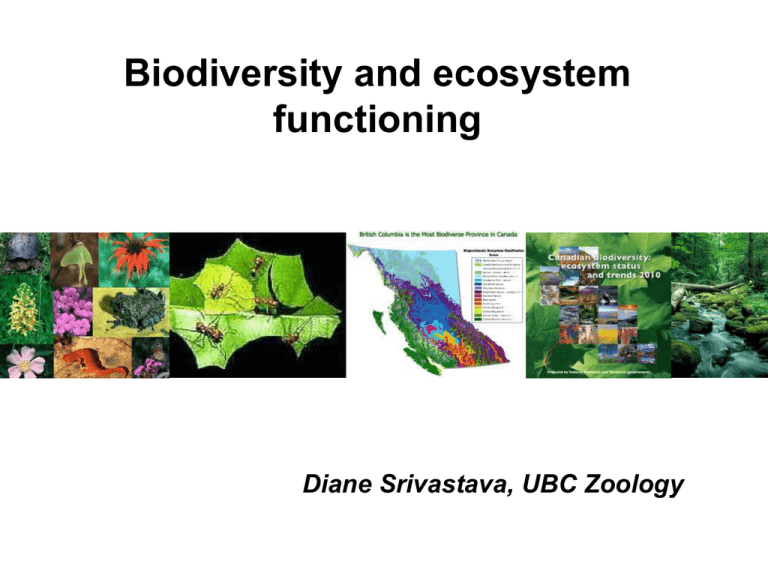
Biodiversity and ecosystem functioning Diane Srivastava, UBC Zoology In the 20 years since the Conventional on Biological Diversity was signed at Rio …what have we learnt about biodiversity loss? …what have we done about biodiversity loss? Ecological - Economic conflicts prior to Rio Human activity: • Habitat loss • Pollution • Overharvesting ECOLOGICAL LOSS ECONOMIC WIN Conversion of Ecological Capital to Economic Capital Biodiversity loss Ethical and aesthetic costs not measured in $ Economic growth measured in $ how to compare? Reasons to conserve species diversity: • Ethical and aesthetic • Evolutionary capital • Functional importance in ecosystems & ecosystem services to humans Ecosystem functions are biological processes that involve the flow of energy and nutrients in, out and through food webs. - Carbon fixation Water purification Pollination Decomposition Pest suppression Production of biomass Nitrogen fixation Energy flow through food webs Ecosystem services are those ecosystem functions that benefit humans. The value of the world’s ecosystem services: $33 trillion Costanza et al. 1997 Nature 387: 253-260. Ecological - Economic conflicts post Rio Human activity: • Habitat loss • Pollution • Overharvesting ECOLOGICAL LOSS Biodiversity loss Ecosystem service costs measured in $ Global wetlands: $3.4 billion ECONOMIC WIN Conversion of Ecological Capital to Economic Capital Economic growth measured in $ can compare! Example 1: Pollination Ecosystem service value: $195 billion for global agriculture Pollinator diversity is declining globally (e.g local diversity of native bees in Europe is half of pre-1980 values) Distribution of bee-dependent plants is declining (e.g. 12- 22% in Europe since 1980s) But does pollinator diversity really increase pollination? Yes! Pollinator diversity increases pollination and crop yield Pumpkin, Indonesia Coffee, Indonesia Watermelon, California Farms near forests in Costa Rica have 20% greater yield due to higher native pollinator diversity, translating into $60,000 more income for the farmer Example 2: Water purification Nitrate uptake Ecosystem service value: New York City $7 billion Algal species diversity Example 3: Carbon fixation Terrestrial plants sequester 2.6 x 109 g C per year offsetting 30% of atmospheric carbon emissions Ecosystem service value: set by carbon credits and other instruments, globally in the trillions So plants are valuable – but do we need so many species? Yes! Most (86% of 272) experiments show that plant Random loss of species can reduce function increases plant (in this case,diversity plant biomass) production ( = C fixation) Tilman, D. et al. 2001. Science 294: 843-5. Example 4: Stability Ecosystem service value: economic prosperity depends on predictable rates of return on investment. Marine systems: Loss of biodiversity concomitant with increase in risks Example 4: Stability A system with no consumptive resistance: Mountain pine beetle attack of monoculture forest Overall – biodiversity increases ecosystem functioning Meta-analysis of 111 experiments (Cardinale, Srivastava et al. Nature 2006) Biomass production and resource consumption increases with diversity of: • • • • plants detritivores herbivores predators in both terrestrial and aquatic systems Losing biodiversity is like losing rivets on an airplane – eventually catastrophic failure Plant production Nutrient uptake Decomposition Mechanisms: (1) Niche complementarity Competitive exclusion principle: Species need to be different that each other in order to coexist Optimal stream flow Species differ in their use of microhabitats and resources, and so complement each other functionally Mayfly Stonefly Sensitivity to disturbance Mechanisms: (2) Facilitation • Species may help each other with function. For example, clover fixes nitrogen which grasses use for biomass production. • A field with both clover and grass may therefore be more productive than one with just one of these species. • e.g.: Farmers often “intercrop” to get higher yields. Mechanisms: (3) Portfolio effect • If species fluctuate independently, their net biomass (or function) may not fluctuate much as individual fluctuations may cancel each other out. • Thus more diverse communities may have lower variability than depauperate communities. • Rationale taken from economics: to reduce risk, investors “diversify” their stocks. Problem # 1 All BDEF experiments are in small, homogeneous plots or bottles. The real world might be different! Problem # 1….is not that much of a problem If anything, adding realistic amounts of spatial heterogeneity strengthens the BDEF relationship Increasing heterogeneity Heterogeneous streams Homogeneous streams Problem # 2 Most BDEF experiments are based on random-loss. But we know extinctions aren’t random! Tend to lose first: • Pollution sensitive species • Rare species • Large species • Predators Problem # 2….is not that much of a problem Expected order of species loss usually exacerbates the effects of species loss on ecosystem function* Functionally important species often the most vulnerable Nutrient release from marine sediments Species richness * 9 out of 11 studies that formally compare real and random-loss scenarios, Duffy et al. 2009 Problem # 3 Sure, diverse ecosystems function better than the average monoculture, but not better than the best monoculture We could optimize carbon sequestration by replacing native forests with ecualyptus monocultures! best Problem # 3…true only for one function! If we consider optimizing multiple ecosystem functions, there is no “magic” monoculture In the 20 years since the Conventional on Biological Diversity was signed at Rio …what have we learnt about biodiversity loss? High certainty about impacts for humanity …what have we done about biodiversity loss? Not enough, over to you today!

